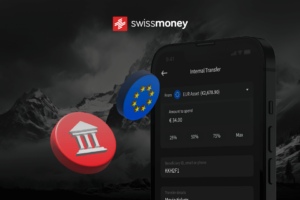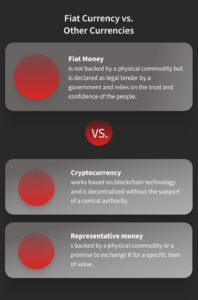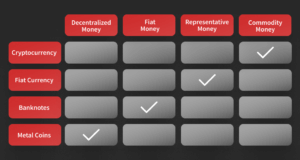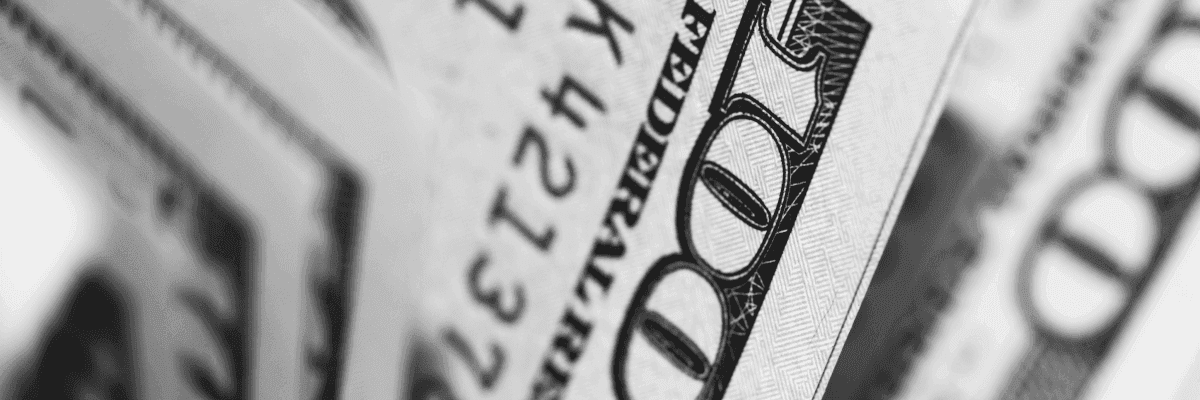The emergence of cryptocurrencies has revolutionized finance by creating innovative digital assets that operate in decentralized networks.
As the world becomes more familiar with Bitcoin, Ethereum, and blockchain technology, another new term in the cryptocurrency space is “fiat”. But what exactly does “fiat” mean in the context of cryptocurrencies?
In this article, we dive deeper into the concept of fiat in the cryptocurrency sphere, exploring its origins, relationship with traditional currencies, commercial banks, central banks, and more. We also discussed the concept of a fiat wallet. Take a look to gain a clearer understanding of its functionality.

Fiat money
Fiat currency, also known as fiat money, is a government-issued currency that lacks physical backing. It, therefore, has no intrinsic value. Instead, its value is established by the public through the trust placed in the issuing government.
Unlike cryptocurrencies, fiat currency is under centralized control by the central bank and government authorities such as the federal reserve.
The decisions which these institutions make influence their value. Therefore, fiat money is not tied to stocks of precious metals. Major global currencies such as the U.S. dollar, the euro, and others fall into the category of fiat currencies.
Fiat money relies on the dynamics of supply and demand as well as the stability of the issuing government to maintain its value. It has no intrinsic value.
Its worth derives only from its perceived usefulness as a medium of exchange. Historically it had a physical commodity backing specific goods.
Nevertheless, fiat currency is not without risks. It is vulnerable to inflation and, in extreme cases, to hyperinflation, which can lead to rapid loss of value. Moreover, if public confidence in a country’s own currency declines, its value can fall.
In contrast, the inherent value of currencies backed by physical commodities such as gold is due to the demand for these commodities in various industries.
Overall, fiat currency represents a significant part of the global financial system, serving as a widely accepted medium of exchange, despite lacking physical backing and relying on the trust and stability of governments.
The value of fiat currencies
In the past, dollars had physical assets such as gold, silver, or print paper money as reserves. It was backing them with value.
However, in the 1930s, the US abandoned the gold standard for domestic transactions and, in 1971, stopped international conversion to the gold standard altogether. Since the 1960s, dollars have not been exchanged for silver.
Presently, the U.S. Federal Reserve is obligated to hold collateral equivalent to the value of circulating dollars, achieved through government-issued debt.
Consequently, the value of the doll derives from two primary factors:
- The affirmation of value by the U.S. government.
- The trust and confidence of global investors and lenders in the U.S. government’s commitment to repay its debts.
In general, several factors drive fiat money’s value:
Government decree
Fiat money gains value primarily because the government declares it as legal tender. It means it is recognized and accepted as a valid form of payment within the country.
Government backing
Although physical commodities like gold or silver don’t back fiat money, the trust and confidence in the government’s ability to maintain the stability and value of the currency support it.
The government’s commitment to managing the economy, implementing monetary policies, and ensuring the financial system’s stability contributes to the perceived value of fiat money.
Acceptance in the economy
Fiat money is widely accepted as a medium of exchange within an economy. Individuals, businesses, and institutions use fiat money for conducting transactions, which further reinforces its value and utility.
Legal tender status
Fiat money is legally recognized as the official currency in a specific jurisdiction. It means that it must be recognized as a form of payment, and refusal to accept it may have legal consequences. This mandatory recognition increases the value and availability of fiat money.
Trust and confidence
The value of fiat money also relies on the trust and confidence of the general public – its stability and purchasing power. People are more likely to accept and hold a currency’s value when they have faith in its stability and believe it will retain its value over time.
Overall, the combination of government regulation, decree, support, recognition, legal status, public trust, and confidence combine to determine the value of fiat money.
Advantages of fiat money
Fiat currencies became popular in the 20th century as governments and central banks sought to protect their economies from the volatile ups and downs of the business cycle. By using fiat money, governments and central authorities can better control economic variables and mitigate the negative effects of natural economic fluctuations.
Due to their ability to manage the money supply, control economic variables, and adapt to changing economic conditions, fiat currencies have become an integral part of the modern economy in most developed countries, providing a flexible, cost-efficient, and controllable monetary system.
First, fiat money is very cost-effective and easy to carry and exchange. Unlike commodities like gold, fiat money is not scarce. As a result, they are available in abundance.
Another significant benefit of fiat money – a specific commodity doesn’t back it. This grants governments control over the currency supply. The control empowers them to manage crucial economic variables: interest rates, liquidity, and credit supply.
Governments can use this control to protect countries from financial crises and to achieve specific economic objectives. For instance, in developed countries such as the US, the Federal Reserve has a dual mandate to keep unemployment low and control inflation.
Also, fiat money is a practical currency when it successfully fulfills the main roles in the national economy. These roles include storing value, digitally recording transactions, and facilitating smooth exchanges between individuals and businesses.
In contrast to currencies directly tied to commodities, fiat currencies boast excellent seigniorage, referring to their cost efficiency in production. This cost-effectiveness increases their practicality in modern economies and reduces the costs associated with currency production.
Disadvantages of fiat money
Even though fiat money grants governments control over currency supply, unfortunately, it does not guarantee absolute protection against financial crises.
One of the cons is its susceptibility to inflation. Governments may mismanage and excessively print too much money. Government regulations and fiscal policies may influence the value of fiat money. It makes fiat money vulnerable to price bubbles: sudden and significant price increases followed by rapid declines.
The 2007 mortgage crisis and the subsequent financial meltdown challenged the belief that any central bank could effectively prevent severe recessions or depressions through fiscal policy.
Comparatively, a currency tied to a tangible asset such as gold is more stable because of the limited and finite supply of gold. In contrast, an unlimited supply of fiat money creates more opportunities for price bubbles.

Fiat currency vs. representative money
Unlike fiat money, it is the government that creates representative money. It backs them with a tangible commodity.
There are various forms of representational money: credit cards, dollar bills, and cheques. They symbolize the intention to make a payment.
Fiat money is backed by government support. On the other hand, representative money can be backed by various assets. In the case of a check or credit card, funds in a bank account back it.
Fiat currency vs. cryptocurrency
Unlike fiat money, cryptocurrency works based on blockchain technology and is decentralized without the support of a central authority.
Compared to fiat money, any digital currency is more volatile and has greater information security. However, in most countries, global transactions are still based on fiat currency. The state centralizes and controls fiat money, and the main examples are the US dollar, the British pound sterling, and the euro.
Cryptocurrencies serve as money. They facilitate exchange and store value. Their main unique advantages are their worldwide availability and their independence from banks or governments, which is revolutionary.
In contrast, fiat money essentially represents government debt. It is because central banks simultaneously issue currency and allocate part of the government debt to consumers. This situation happens in systems such as the EU, and the US.

Fiat money vs. commodity money
Commodity money has intrinsic value. This means that this type of money is made from a material with value (gold or silver). In contrast, fiat money has no intrinsic value.
FAQ:
What does fiat to crypto mean?
Fiat to crypto refers to buying crypto as Bitcoin using fiat currency. The term originated due to the limitations of previous online trading platforms, where trading was mainly limited to cryptocurrency-to-crypto transactions.
In this case, if you had Bitcoins, you could exchange them for Litecoins, and if you had Litecoins, you could exchange them for ethers. However, you couldn’t buy Ether or Litecoin directly for US dollars on most platforms.
While bitcoins were available on several major exchanges, to hold other altcoins, you had to transfer bitcoins to another crypto platform. The process often took several days.
Therefore, when more sophisticated online exchanges emerged, they promoted the possibility of exchanging fiat for crypto as a distinctive feature that set them apart from their predecessors.
What are fiat money and crypto?
Fiat money is a legal tender whose value determines the government. Cryptocurrency, on the other hand, is a digital asset whose value derives from the underlying blockchain technology that created it.
What is an example of fiat in crypto?
There are many fiat currencies. Some of them are these:
- U.S. dollar (USD)
- Euro (EUR)
- British Pound (GBP)
- Mexican pesos (MXN)
- Indian rupee (INR)
Why is it called fiat money?
Fiat means an official order or decree. When a government decrees a currency, it is considered a fiat currency. This decree is visible in the case of dollar notes: This note is legal tender for all debts, public and private.
Why is it called fiat currency?
Fiat money and Fiat currency mean the same concept. Both terms describe a type of currency issued by a government that has no intrinsic value or any other commodity.

